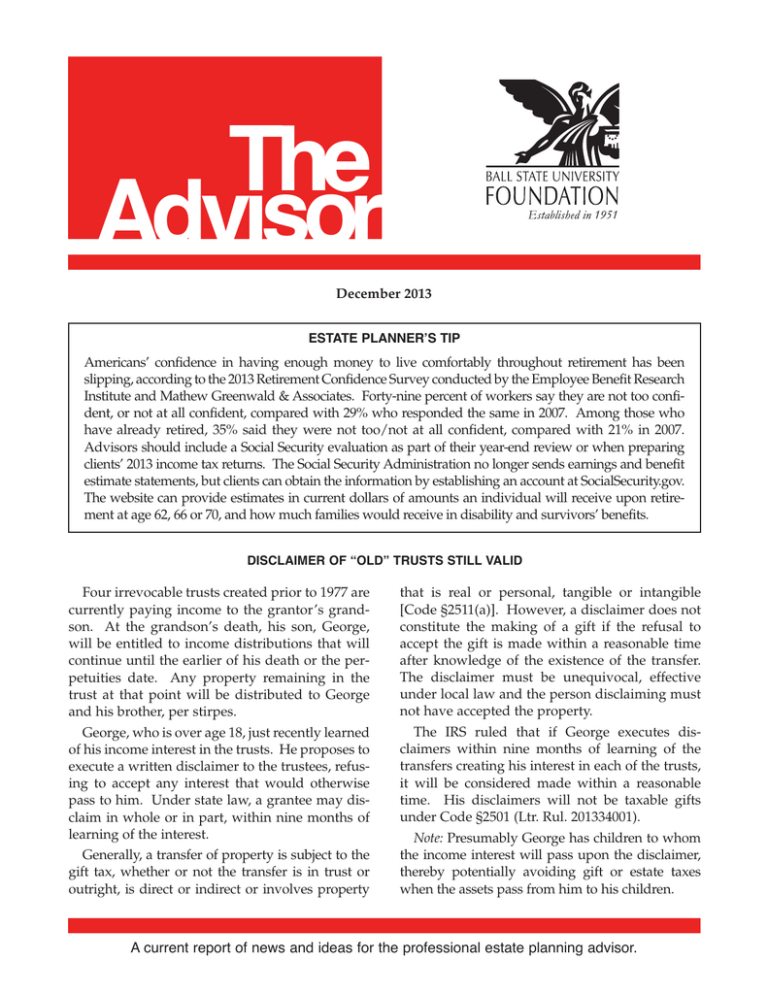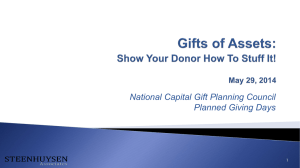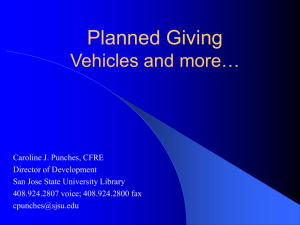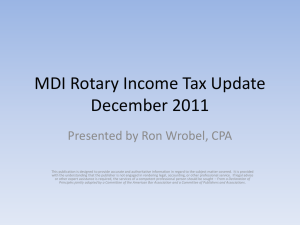The Advisor |
advertisement

The| Advisor December 2013 ESTATE PLANNER’S TIP Americans’ confidence in having enough money to live comfortably throughout retirement has been slipping, according to the 2013 Retirement Confidence Survey conducted by the Employee Benefit Research Institute and Mathew Greenwald & Associates. Forty-nine percent of workers say they are not too confident, or not at all confident, compared with 29% who responded the same in 2007. Among those who have already retired, 35% said they were not too/not at all confident, compared with 21% in 2007. Advisors should include a Social Security evaluation as part of their year-end review or when preparing clients’ 2013 income tax returns. The Social Security Administration no longer sends earnings and benefit estimate statements, but clients can obtain the information by establishing an account at SocialSecurity.gov. The website can provide estimates in current dollars of amounts an individual will receive upon retirement at age 62, 66 or 70, and how much families would receive in disability and survivors’ benefits. DISCLAIMER OF “OLD” TRUSTS STILL VALID Four irrevocable trusts created prior to 1977 are currently paying income to the grantor’s grandson. At the grandson’s death, his son, George, will be entitled to income distributions that will continue until the earlier of his death or the perpetuities date. Any property remaining in the trust at that point will be distributed to George and his brother, per stirpes. that is real or personal, tangible or intangible [Code §2511(a)]. However, a disclaimer does not constitute the making of a gift if the refusal to accept the gift is made within a reasonable time after knowledge of the existence of the transfer. The disclaimer must be unequivocal, effective under local law and the person disclaiming must not have accepted the property. George, who is over age 18, just recently learned of his income interest in the trusts. He proposes to execute a written disclaimer to the trustees, refusing to accept any interest that would otherwise pass to him. Under state law, a grantee may disclaim in whole or in part, within nine months of learning of the interest. Generally, a transfer of property is subject to the gift tax, whether or not the transfer is in trust or outright, is direct or indirect or involves property The IRS ruled that if George executes disclaimers within nine months of learning of the transfers creating his interest in each of the trusts, it will be considered made within a reasonable time. His disclaimers will not be taxable gifts under Code §2501 (Ltr. Rul. 201334001). Note: Presumably George has children to whom the income interest will pass upon the disclaimer, thereby potentially avoiding gift or estate taxes when the assets pass from him to his children. A current report of news and ideas for the professional estate planning advisor. The Advisor WILL CHALLENGE COMES TOO LATE Olga Ferretti’s 2003 will included specific bequests to charity and several of her nieces and nephews. The residue was left to her surviving sisters. In 2005, Ferretti executed another will and living trust leaving her estate to her four surviving sisters, but if any sister predeceased her, that onequarter share was to pass per stirpes. Another sister, Mary Vescovi, had predeceased Olga, but her children were not to receive a share. Ferretti also established a charitable remainder unitrust that was to pay income to her for life, and then to her sisters for the shorter of their joint lives or ten years. At Ferretti’s death in 2010, one of Vescovi’s daughters, Joann, sought to have the 2005 will and trust declared null and void, saying there was undue influence. Notice of the action was sent to Joann’s sister, Elaine, in La Jolla, CA. Elaine did not file any response by the April 20, 2011 deadline. The estate reached a settlement with Joann, paying her $6,000 to dismiss the challenge. In September 2011, Elaine filed suit against the executor, claiming undue influence and diminished capacity. She said she had moved from La Jolla before the notice arrived, had vision problems and lacked funds to obtain legal counsel. She said she thought she was already a party to the litigation. The estate sought to dismiss Elaine’s action, saying it was outside the statute of limitations. PHILANTHROPY PUZZLER Eight years ago, when his grandson was age ten, Richard created a charitable remainder trust to last for a term of 20 years. Being a firm believer in family tradition, Richard included a provision stating that the income interest would end earlier than 20 years if the grandson did not attend Richard’s alma mater. The grandchild has selected a different college. Richard has asked if he is entitled to an additional charitable deduction for the early distribution of trust assets to the remainderman. How do you advise him? The trial court dismissed Elaine’s complaint. The Superior Court of New Jersey agreed, noting that although state law permits relief from the statute of limitations, it requires a showing of “extraordinary circumstances.” Elaine’s inability to retain counsel does not rise to the level that would permit relief from the time limitations for challenges, ruled the court (In re Estate of Ferretti, Docket No. A-3270-11T1). CHARITY SENT TO DOGHOUSE Bernard and Jeanne Adler were long-time, modest donors to SAVE, a no-kill animal shelter. When the organization announced plans to build a 35,000-square-foot facility, the Adlers were particularly interested in special rooms planned for larger dogs and older cats. These animals are generally more difficult to adopt out, and the Adlers wanted comfortable rooms for them to stay for longer periods. The couple pledged $50,000 for the naming rights for the two “living rooms.” Two years after the Adlers had satisfied their pledge, SAVE announced it was merging with another charity. The newly merged organization would still be building a new facility, but it would be only about one-tenth the size of the original, would be located in another county and would not include rooms devoted solely to larger dogs and older cats. When SAVE refused the Adlers’ request that their gift be returned, the couple filed suit. The trial court, finding that the Adlers made the gifts only for the purpose of funding the special rooms, ordered the contributions be returned. SAVE appealed, arguing that the trial court should have reformed the Adlers’ gift under the doctrine of equitable deviation, adding that to order the return of the gift would be “detrimental to charities.” The Superior Court of New Jersey Appellate Division said the evidence “overwhelmingly” supported the trial court findings. SAVE accepted the couple’s gift knowing that funding the rooms was an express condition, yet unilaterally decided not to honor the stated purpose. The court added that returning the gift was “a mild sanction” for what it called SAVE’s breach of fiduciary duty. The Advisor The court also rejected SAVE’s argument that the doctrine of cy pres should be applied. It would be “a perversion of these equitable principles,” said the court, to permit a charity to aggressively solicit funds, accept the donor’s express conditions and then disregard the conditions, without even asking the donors what other use would as nearly as possible fit their original purpose. Responsible charities will welcome this decision, the court said, because prospective donors will know that the express conditions of their gifts will be legally enforceable (Adler v. SAVE, Docket No. A-0643-10T3). LACK OF APPRAISAL REDUCES DEDUCTION Jay and Cynthia Haskett made separate cash gifts of $1,000 and $250 in 2008 to their local humane society in connection with a charity preview and auction. They received a receipt indicating donations were deductible to the extent that they exceeded $50 per person for the value of refreshments. The same year, Cynthia made several donations of clothing and household items to the humane society’s thrift shop. The receipts she received estimated the value of the goods. The couple claimed $1,250 in cash contributions and $10,000 in contributions of clothing and housewares to the thrift shop. The IRS disallowed all but $1,050 of cash contributions and $3,600 thrift shop contributions. The Tax Court said the $50 per person value placed on the refreshments covered both the preview party and the auction and that the Hasketts had adequately substantiated cash gifts of $1,150. However, for the noncash gifts in excess of $500, the couple lacked sufficient substantiation. Reg. §1.170A-13(b)(3) requires that they maintain records showing how the donated items were acquired, the approximate date of acquisition and the cost or adjusted basis of the property. The court said they lacked these records and failed to show reasonable cause for not providing the information. In addition, Reg. §1.170A13(b)(2)(ii)(c)(2) requires a qualified appraisal for noncash gifts in excess of $5,000. For purposes of determining whether a donor has reached the $500 or $5,000 thresholds, all similar items of property are aggregated. The Hasketts did not have a qualified appraisal for the clothing or household items, the court said, noting that the donee or an employee of the donee cannot serve as a qualified appraiser [Reg. §1.170A13(c)(5)(iv)(C) and (D). Their deduction for the noncash gifts was limited to the amount allowed by the IRS (Haskett v. Commissioner, T.C. Summary Opinion 2013-76). DEDUCTION NOT DEPRECIATED Largesse Corp. owns real property that has been fully depreciated and is considered Code §1250 property. Generally, when Code §1250 property is disposed of, 20% of the excess, if any, of (a) the amount that would be treated as ordinary income if the property was §1245 property, over (b) the amount treated as ordinary income under §1250, shall be treated as ordinary income. Largesse plans to contribute the property to one or more charities and asked the IRS whether its charitable deduction would be reduced by 20% of the accumulated depreciation. The IRS noted that the charitable recipients will have a basis in the property equal to Largesse’s basis at the time of the gift. The contribution of the property is a gift for purposes of Code §1250(d)(1) and Reg. §1.1250-3(a)(1), said the IRS. Therefore, Largesse’s charitable deduction will not be reduced by 20% of the accumulated depreciation of the property, the IRS ruled (Ltr. Rul. 201318003). PUZZLER SOLUTION A charitable remainder trust normally must pay income for life or a term of no more than 20 years [Code §664(d)(1)(A)], although a trust that ends earlier on the happening of a “qualified contingency” will not be disqualified [Code §664(f)]. The deduction is determined without reference to the possibility that the contingency will occur [Code §664(f)(2)], so Richard is not entitled to an additional charitable deduction for the early distribution to the remainder beneficiary. The Advisor LANDING A CHARITABLE DEDUCTION WHILE INTEREST RATES ARE LOW Sec. 7520 rates have started inching upwards lately, after hitting an all-time low of 1.2% three times in 2013. The rates are used to value splitinterest charitable gifts. Low §7520 rates generally make the charitable deduction less attractive for most split-interest gifts (charitable remainder annuity trusts, unitrusts, charitable gift annuities), but there’s one gift technique that shines in times of low §7520 rates: a gift of a remainder interest in a home or farm [Code §170(f)(3)(B)(i)]. Unlike other split-interest gifts, this one doesn’t pay income, but it does allow the donor to continue using the property for life. From the donor’s perspective, this type of gift is nearly “invisible.” Consider a donor, age 67, who owns land worth $250,000 that is currently used for farming. If he contributes a remainder interest in the property to his favorite charity, his charitable deduction would be $183,398 (using a §7520 rate of 2%). The same gift calculated with a §7520 rate of 6% – a rate not seen since mid-2007 – would yield a deduction of only $108,408. The donor can continue farming the property himself or rent it and keep the income. What constitutes a “farm”? Reg. §1.170A7(b)(4) defines it as any land used by the donor or his or her tenant for the production of crops, fruits or other agricultural products or for the sustenance of livestock, including cattle, hogs, horses, mules, donkeys, sheep, goats, captive furbearing animals, chickens, turkeys, pigeons and other poultry. Improvements on the farmland also are included in the definition. A donor can also contribute a remainder interest in a personal residence. It need not be the donor’s principal residence [Reg. §1.170A-7(b)(3)]. Therefore, a donor may contribute a remainder interest in a vacation home and continue to use Cherí E. O’Neill President and CEO the home for life. Consider Earl and Alice, ages 70 and 73, who own a second home in a popular vacation area. Assuming the value of the land to be $200,000 and the value of the home to be $400,000, their deduction would be $319,424 at a §7520 rate of 2%. At a §7520 rate of 6%, the deduction would be only $178,310. The deduction computation requires that the donor determine depreciation on the structure, as well as its value at the end of the useful life, even though the value of a home may actually appreciate rather than depreciate. There are a few issues that should be addressed before making a gift of a remainder interest in a home or farm: What if the donor later wants to sell the property? The donor and charity can jointly agree to sell the property, with each taking the respective actuarial value of the sale proceeds. The gift cannot be conditioned on charity being required to sell at some future time [Rev. Rul. 77-305, 1977-2 C.B. 72]. The donor could also make a second gift to charity of his or her retained life interest in the property, thereby qualifying for an additional charitable deduction. Who is responsible for expenses during the donor’s life? Most state laws address the rights and responsibilities of a life tenant (e.g., insurance, maintenance, taxes). Nevertheless, its is a good idea for the donor and charity to have a written agreement governing these issues. Will the donor be able to use the entire deduction? The deduction for remainders in homes and farms is subject to a 30%-of-AGI limit [Reg. §1.170A-8(d)(3)]. Although there is a five-year carryover for excess deductions, the donor may be unable to use the full amount in six years [Code §170(b)(1)(B)]. BALL STATE UNIVERSITY FOUNDATION P.O. Box 672, Muncie, IN 47308 (765) 285-8312 • (765) 285-7060 FAX Toll Free (888) 235-0058 www.bsu.edu/bsufoundation Philip M. Purcell, J.D. Vice President for Planned Giving and Endowment Stewardship If you know another professional advisor who would benefit from this publication, please contact The Foundation.



